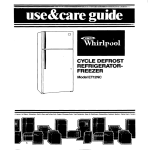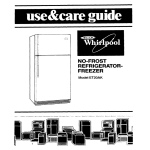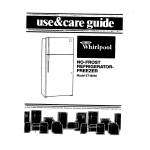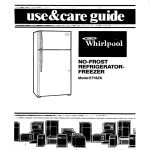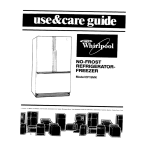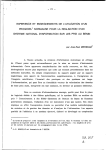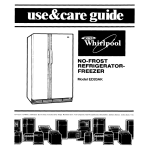Download Whirlpool EL15SC Specifications
Transcript
MANUAL DEFROST REFRIGERATORFREEZER Model EL15SC ‘o:-Freezers Ice Makers, Dishwashers. Buill-In Ovens and Surlace Units, Ranges. Microwave Ovens, Trash Compactors. Room Air Conditioners. Dehumidilieo. Aulomallc Washers. Clothes Dryers. Flew? - [ r Please read this Use and Care Guide before you do anything else... This booklet tells you how to start your refrigerator, clean it, move shelves andadjust controls. It even tells you what new sounds to expect from your refrigerator. Treat your new refrigerator with care. Use it only to do what home refrigerators are designed to do. Parts and features FREEZER COMPARTMENT ICE CUBE TEMPERATURE CRISPER Copy your Model and Serial Numbers here... When you need service or call with a question, have this information ready: 1. Complete Model and Serial Numbers (from the plate located as shown]. 2. Purchase date from sales slip. Copy this information in these spaces. Keep this book, your warranty and sales slip together in a handy place. Please complete and mail the Owner Registration Card furnished with this product. 2 Model Number Serial Number Pu,chose Do,e Service Company and Telephone Number Contents Page PARTS AND FEATURES ................. SAFETY FIRST .......................... BEFORE YOU PLUG IT IN ................ Install Properly ...................... ........... Level Refrigerator-Freezer Remove Sales Labels. ............... Clean It ............................. Plug Itln ............................ .......................... TurnItOn.. USING YOUR REFRIGERATOR .......... Setting the Controls. ................. The Freezer Tray ..................... Changing the Light Bulb ............. Adjusting the Refrigerator Shelves ... Removing Crisper and Crisper Cover .................... IceCubeTrays.. Sounds You May Hear ............... Energy Saving Tips .................. DEFROSTING AND CLEANING YOUR REFRIGERATOR ........................ Defrosting the Freezer Compartment ........... Cleaning the Refrigerator Cleaning Chart ..................... FOOD STORAGE GUIDE ................ Storing Fresh Food .................. Freezing and Storing Frozen Foods .. VACATION AND MOVING CARE ....... IF YOU NEED SERVICE OR ASSISTANCE WHIRLPOOL REFRIGERATOR WARRANTY ........................... 2 3 3 4 4 4 4 4 4 5 5 5 6 6 6 01987 Whirlpool 6 6 7 7 8 9 9 10 13 14 16 Corporation Before you plug it in Important Before using your refrigerator, you are personally responsible for making sure that it... l is installed and leveled on a floor that will hold the weight, and in an area suitable for its size and use. l is connected only to the right kind of outlet, with the right electrical supply and grounding. [Refer to your “Electrical Requirements and Grounding Instructions:‘) l is used only for jobs expected of home refrigerators. l l l l l l is not near an oven, radiator or other heat source. is properly maintained. is out of the weather. is used in an area where the room temperature will not fall below 55°F (13°C). is not used by those who may not understand how it should be used. is not loaded with food before it has time to get properly cold. Remove sales labels... Install properly... Remove the Consumer Buy Guide label, tape and any inside labels before using the refrigerator To remove any remaining glue: 1. Rub briskly with thumb to make a ball then remove. OR 2. Soak area with liquid hand dishwashing detergent before removing glue as described in step 1. DO NOT USE rubbing alcohol or flammable or toxic solvents, such as acetone, gasoline, carbon tetrachloride, etc. These can damage the material. NOTE: DO NOT REMOVE ANY PERMANENT INSTRUCTIONS LABELS INSIDE YOUR REFRIGERATOR. Do not remove the Tech sheet fastened under the refrigerator at the front. Clean it... 1. Allow 3 inches (7.5 cm] between overhead cabinets and the refrigerator top 2. Allow at least an inch (2.5 cm] between the refrigerator condenser on the back and the wall 3. Allow ‘12 inch (1.25 cm) on each side of the refrigerator for ease of installation. 4. If the refrigerator is to be against a wall, you might want to leave extra space on the hinge side so the door can be opened wider Clean your refrigerator before using it. See cleaning instructions plugging on page it in or 7. Plug it in... 3-PRONG GROUNDING TYPE WALL RECEPTACLE Level refrigerator-freezer... REFRIGERATOR POWER CORD LEVELLING LEG RECOMMENDED RAISE LOWER 1. Keep the 4 bolts that held refrigerator in shrpping crate. They are the levelling legs 2. Screw these bolts all the way into bolts holes at the bottom corners of refrigerator. 3. Adjust each leg until the refrigerator won’t rock Slide refrigerator into place 4. Adjust front legs to level the refrigerator. - To raise corners, turn legs in direction shown -To lower corners, turn legs in direction shown. 5. Check with level. J-PRONG GROUNDING PLUG GROUNDING METHOD A 115 Volt, 60 Hz, AC only 15 or 20 ampere fused and properly grounded electrical supply is required. It IS recommended that a separate circuit serving only this appliance be provided Do not use an extension cord. Use a receptacle which cannot be turned off with a switch or pull chain. See individual electrical requirements and grounding instruction sheet in your literature package Turn it on... Move Run Switch to ON. NOTE: The refrigerator motor will not operate til the Run Switch is set to ON. l 4 un- Using your refrigerator TEMPERATURE CONTROL LIGHT SWITCH RUN SWITCH Setting the control... The control for the refrigerator temperature is in Give the refrigerator the EfrigerCItOr. When the refrigerator is plugged in pletely before adding and the Run Switch is moved to ON: era1 hours.) Set the Thermostat Control to 3. (This This setting should be about household refrigerator usage. TEMPERATURE l time to cool food. down may take comsev- right for normal - The control will be set about right when milk or juice is as cold as you like. In hot weather or if the door is opened often, turn the control to a higher number to keep the temperature you like. If the milk or juice is too cold or refrigerator items start to freeze, turn the control to a lower number or adjust the freezer tray damper. Wait 24 hours after an adjustment is made before further change is made to the controls. 1 The freezer tray.. The freezer compartment. tray is located under the freezer The damper at the rear of the freezer tray helps control the refrigerator temperature for warm weather operation. The damper can be adjusted for proper cooling and defrosting of the refrigerator. To adjust the damper: 1. Pull out the freezer tray. 2. Lift out the damper from the rear of the tray. 3. Slide damper into the desired position. NOTE: “B, C, D” positions provide fine cooling adjustments to best meet your cooling needs in warm weather. POSITIONS A - (Closed) COOLING AND DEFROSTING. DE - (FULL Open] N FOR WARM WEATHER SETTING. 5 Changing the light bulb... Adjusting the refrigerator shelves... To remove the shelf: 1. First, remove food from shelf. GUIDE STOP 2. Slide shelf straight out to stop. 3. Lift front, slide shelf the rest of the way out. SHELFSToP To replace the shelf: 1. Fit back of shelf on top of guides with wire stops on the bottom of guides. 2. Lift front, slide shelf in until it clears guide stops. Removing crisper and crisper cover... LlFl THE FRONT AND PULL AGAIN. To remove fhe cover: 1. Lift front, then lift back. 2. Pull up and out To replace the cover: 1. Fit notches on back of cover supports. 2. Lower front into place. into back wall Ice cube trays... For best results when freezing ice cubes, place ice cube trays side-by-side in bottom of freezer compartment. If cubes are not used, then may shrink. The longer cubes are stored, the smaller they get. F LylIy%oth 2. Slightly twist. ends. Sounds you may hear... Your new refrigerator may make sounds that your old one didn’t. Because the sounds are new to you, you might be concerned about them. Don’t be. Most of the new sounds are normal, Hard surfaces like the floor, walls and cabinets can make the sounds seem louder. The following chart describes the kinds of sounds that might be new to you, and what may be making them. Possible l Water l Running Sounds: Sounds: Sounds: Probable Causes: When the refrigerator stops running, you may hear gurgling for a few minutes after it stops. in the tubing Your refrigerator has a high-efficiency compressor motor. It will run longer than older designs. It may even seem to run most of the time. Energy saving tips... You can help your refrigerator use less electricity. Check door gaskets for a tight seal. Level the cabinet to be sure of a good seal. l Clean the condenser coil regularly. l Open the door as few times as possible. Think about what you need before you open the door. Get everything out at one time. Keep foods organized so you won’t have to search for what you want. Close door as soon as food is removed. l Go ahead and fill up the refrigerator, but don’t over crowd it so air movement is blocked. l l l It is a waste of electricity to set the refrigerator and freezer to temperatures colder than they need to be. If ice cream is firm in the freezer and drinks are as cold as your family likes them, that’s cold enough. Make sure your refrigerator is not next to a heat source such as a range, water heater, furnace, radiator or in direct sunlight. Defrosting and cleaning your refrigerator The freezer compartment in your refrigerator should be defrosted whenever frost builds up to Y4-inch (6 mm). The entire refrigerator should be cleaned about once a month to help prevent odors from building up. Of course, spills should be wiped up right away. Defrosting the freezer compartment... 1. Move the Run Switch to “OFF” 2. Remove food and ice cube trays. Wrap food in newspaper and put in a cooler to keep frozen. 3. Make sure the freezer tray damper is in the “A” position. 4. Place a pan of hot water in the freezer compartment to speed defrosting. Leave door open. 5. CAUTION: Do not use any type of electric defroster or sharp utensils (ice pick, knife, etc.) to speed defrosting. These can cause damage. Scrape with plastic window scraper. 6. Replace hot water every 10 to 15 minutes. 7. Soak up defrost water with a cloth or sponge. 8. Empty defrost water from freezer tray. (Pull out to stops; lift front slightly: pull out the rest of the way.1 9. Clean compartment and freezer tray with a solution of two tablespoons (26 g) of baking soda and one quart (.95 I) of warm water. Rinse well and dry 10. Replace food and ice cube trays. 11. Move the Run Switch to ON. COOLING AND DEFROSTING. Cleaning the refrigerator... To clean your refrigerator, move the Run Switch to OFF, unplug it, take out all removable parts, and clean it according to the following directions. When cleaning is complete, replace all refrigerparts, plug it in, and move the Run Switch to ON. ator Cleaning chart... How to clean Part What to use Removable parts (shelves, crisper, etc.) Sponge or cloth; mild detergent and warm water. Outside Sponge, cloth or paper towel; mild detergent; appliance wax (or good auto paste wax]. Waxing painted metal l l Wash removable parts with warm and a mild detergent. Rinse and dry. Wash with warm water and a mild detergent. Do not use abrasive or harsh cleansers. l Rinse and dry. l Wax painted metal surfaces at least twice a year with appliance wax or a good auto paste wax. Apply wax with a clean, soft cloth. Do not use wax on plastic parts. surfaces provides rust protection. l Wash with warm water and - mild detergent or - baking soda (2 tablespoons 1 quart [.95 L.] warm water]. Rinse and dry. Inside walls (freezer compartment should be allowed to warm up so cloth won’t stick.) Sponge, soft cloth or paper towel, baking soda, warm water, mild detergent. Door liners and gaskets Wash with mild detergent water. l Rinse and dry. DO NOT USE Cleaning waxes, concentrated detergents, or cleansers containing petroleum on plastic parts. l l Dark plastics (covers and panels] Sponge, soft cloth or paper towel; mild detergent, warm water. water l [26 g] to and warm bleaches l Wash with a soft cloth or sponge. Mild detergent and warm water; soft clean l Rinse and dry. sponge and soft, clean cloth. DO NOT USE paper towels, window sprays, scouring cleansers, or flammable or toxic solvents like acetone, gasoline, carbon tetrachloride, etc. These can scratch or damage the material. Condenser coils Use vacuum cleaner with brush attachment. Floor under refrigerator Usual floor cleaners. l l l l l Clean dust and lint from condenser coils behind the refrigerator at least every other month. Be careful, the fins on the coils are sharp. Slide refrigerator out away from the wall. Clean the floor. Slide refrigerator back into place Check to see if the refrigerator is level. Food storage guide STORING FRESH FOOD Cured or Smoked Meat and Cold Cuts. Ham, bacon, sausage, cold cuts, etc., keep best in origtnal wrappings. Once opened, tightly re-wrap in plastic wrap or aluminum foil. Canned Ham. Store in refrigerator unless the label says it’s okay to store on the shelf. Do not freeze. Fresh Poultry...Wrap in plastic wrap. The plastic on poultry, as purchased, may be used for storage. STORAGECHART FOR FRESHAND CURED MEAT* There is a right way to package and store refrigerated or frozen foods. To keep foods fresher, longer, take the time to study these recommended steps. Leafy Vegetables...Remove store wrapping and trim or tear off bruised and discolored areas. Wash in cold water and drain. Place in plastic bag or plastic container and store in crisper. Cold, moist air helps keep leafy vegetables fresh and crisp. Vegetables with Skins [carrots, peppers)...Store in crisper, plastic bags or plastic container. Fruit...Wash, let dry and store in refrigerator in plastic bags or crisper. Do not wash or hull berries until they are ready to use. Sort and keep berries in their store container in a crisper, or store in a loosely closed paper bag on a refrigerator shelf. Meat* . ..Meat is perishable and expensive.. you won’t want to waste an ounce of it through careless handling. The following list and chart give you packaging hints and time limits. Fresh, Prepackaged Meat. Store fresh meat in the store wrapping. Vacuum packaged meat can be frozen for as long as one month if the seal is not broken. If you want to keep it frozen longer, you should wrap it with special freezer wrapping material. Fresh Meat, Not Prepackaged. Remove the market wrapping paper and re-wrap in aluminum foil for storing it unfrozen. Cooked Meat. Wrap or cover cooked meat with plastic wrap or aluminum foil. Store immediately. Approximate We lime Ways) 1 to 2 1 to 2 1 to 2 3 to 5 7 to 10 5 to 7 3 to 5 Variety Meats ....................... ............................ Chicken Ground Beef ........................ Steaks and Roasts .................. Cured Meats ........................ .............................. Bacon Cold Cuts ........................... ‘If meat is to be stored longer than the times given, follow the directions for freezina. NOTE: Fresh fish and shellfish same day as purchased. should be used the Eggs...Store without washing in the original carton or use the egg nest in the door. Milk...Wipe milk cartons. For best storage, place milk on top interior shelf. Beverages...Wipe bottles and cans. Store on lower door shelves beneath the egg nest or interior shelves. Butter...Store daily needs on serving dish in butter compartment. When storing an extra supply, wrap in air-tight packaging and store in freezer compartment or on top door shelves. Cheese...Store in original wrapping until you are ready to use. Once the package is opened, rewrap tightly in plastic wrap or aluminum foil. Store on interior refrigerator shelves. Condiments...Store catsup, mustard, jelly, olives, pickles, etc on door shelves. NOTE: Store bottled and canned items on the door shelves beneath the egg nest. Lefiovers...Always cover the container with plastic wrap or aluminum foil to keep food from drying. Store on refrigerator shelves. 9 FREEZING & STORING FROZEN FOODS The freezer section is designed for storage of commercially frozen foods and for freezing foods at home. Packaging - The secret of successful freezing is in the packaging. The wrap you use must be air, moisture and vapor proof. The way you close and seal the package must not allow air, moisture or vapor in or out. Packaging done in any other way could cause food odor and taste transfer throughout the refrigerator and drying of frozen food. Rigid polyethylene (plastic) containers with tightfitting lids, straight-sided canning/freezing jars, heavy-duty aluminum foil, plastic-coated paper and nonpermeable plastic wraps (made from a Saran film] are recommended. NOTE: Heatsealed boiling bags are easy to use and can be used by themselves or as carton liners. Sealing-When sealing foods in bags squeeze out the air [liquids need headspace to allow for expansion).Twist the top and turn it back. Fasten tie securely around the doubled-over tail. Put the label inside transparent bags; use self-adhesive label on outside of opaque ones. Air-tight wrapping calls for “drugstore” wrap. Cut the sheet about one-third longer than the distance around the food. Bring the ends together and fold in [toward the food] at least twice to seal out air. Crease ends close to food, press air from package. Fold tips over twice. Finish package and tape closed. NOTE: With unboned meats, pad sharp edges with extra wrap or use stockinette to protect the wrap from punctures. 10 DO NOT USE: Bread wrappers l Non-polyethylene plastic containers l Containers without tight lids l Waxed paper l Waxed-coated freezer wrap l Thin, semi-permeable wrap None of these are totally moisture, air or vapor proof. The use of these wrapplngs could cause food odor and taste transfer and dryIng of frozen food. l Freezing Fruits - Select ripe, blemish-free fruits. Be sure they taste as good as they look. Wash 2 to 3 quarts (liters) at a time and drain. Fruitthat stands in water may lose food value and become soggy. Sort, peel, trim, pit and slice as needed. Pack in rigid wide-mouthed containers or other recommended material. Leave head space to allow liquids to expand during freezing. Freezing Vegetables - Freeze only fresh highquality vegetables picked when barely mature. For best results, freeze no more than 2 to 3 hours after picking. Wash in cold water, sort and cut into appropriate sizes. Blanch or scald. Pack in recommended container and freeze. Do not freeze lettuce, celery, carrot sticks, potatoes or fresh tomatoes. All will become limp or mushy. Tomatoes will collapse when thawed. Freezing Cooked Food-Prepare cooked foods as you would forthe table; shorten cooking time 10 to 15 minutes to allow for additional cooking during reheating. Omit seasonings and part of the liquid. Plan to add them at reheating time. Potatoes should also be added to soup and stew at heating time. Add crumb and cheese toppings at heating time. Cool as rapidly as possible and freeze at once Liquid or semi-liquid dishes may be frozen in recommended containers with head-space. Gas seroles and other more solid foods may be frozen in the baking container. If you don’t want to leave your casserole dish in the freezer, line it with foil. Bake, cool, freeze, lift out the foil package, bag it and return to freezer. Freezing Meats - The meat you thaw can only be as good as the meat you freeze. “Drugstore” wrap in meal-size packages. Flat cuts or patties should be wrapped individually or in layers separated by a double thickness of freezer wrap. Make sure store wrappings are moisture and vapor proof. If not, re-wrap meats with one of the wraps recommended under “Packaging:’ Freezing Baked GoodsWrap baked breads in recommended material. Thaw in wrapping. Unbaked yeast breads can be frozen after the first rising. Punch down, wrap and freeze. Bake cookies as usual. Cool and freeze on trays, then pack in recommended freezer bags or cartons. Unbaked cookies may be dropped, molded or rolled and frozen on cookie trays. Store in bag or carton; bake without thawing. Refrigerator-type cookies can be wrapped and frozen in roll form. Thaw only enough to slice when ready to bake. Fruit pies are best frozen unbaked. Bake without thawing. Bake pecan and similar pies before freezing...rich fillings do not freeze solid. Cut steam vents in top crusts when ready to bake. 11 IMPORTANT: Do not expect your freezer compartment to quick-freeze any large quantity of food. Put no more unfrozen food into the freezer compartment than will freezer with 24 hours. (No more than 2 or 3 pounds of food per cubic foot of freezer space.) leave enough space for air to circulate around packages. Be careful to leave enough room at the front so the door can close tightly. FOOD STORAGECHART Storage times’ will vary according to the quality of the food, the type of packaging or wrap used (moisture and vapor-proof), and the Staragetemperature which should be 0°F ( -17.&C). Stomge Tlme Food FRufTs ........ 12 months Fruit Juice conoentmte 12 months CommerotaflY frozen felt ...... ..... 4to6months Clhustfultandjulces.. 8to12months Olhen .................... VEGETAMS 8 months Commefolally frozen ........... .............. 8to12months Homefrozen MEAT 4 weeks or less Bacon .................... 4 weeks or less Corned beef .............. k;~~neeat shortens freezer life) . ......... ........ ... 1 month Oround beef, lamb, veal .... 2 to 3 months Roasts: 6tol2months Beef .................... 6 to 9 months lamb and veal ........... Pork ...................... 4 to 8 months ............. 1 to2months Sausage,fresh Steaks and chops: Beef .................... Sto12months 3 to 4 months lamb, veal, pork ......... FISH Cod, flounder, haddock sole .......................... 6 months Btue flsh, salmon ........... 2 to 3 months 2 to 3 months Mackerel, peroh ............ ...... 3 months Breaded Ish (purchased) Ohms, oysfen, cooked ....... 3to4months tlsh,cmb,scallops Alaskan king cmb ............ 10 months 12 months Shrimp, uncooked ............. POULTRY 12 months Whofe ohkken or turkey ....... ................................................ 6 months z&s 2 to 3 months ....... 6 months cooked P-W w&mvy ................ 1 month Slloes(nogmvy] MAIH DISHES ‘Btem; meut, pouffry andftshcasseiole.. TV dfnnen .................. 12 ...... 2to3months 3 to 6 months Storage Tlme Food DAIRY PRODUCTS 6 to 9 months Butter ...................... 12 months Margarine ..................... Cheese: Camembert, Mozzarella, 3 months farmer% .. ., ................ DO NOT FREEZE Creamed cottage ...... Cheddar, Edam, Gouda, 6to8weeks Swiss, brick, etc. ........ Freezlng can change texture of cheese. Ice cream, Ice milk, sherbet ..... 2 months EGGS 12 months Whole (mlxed) ................. 12months Whites ......................... 12 months Yolks ........................... [Add sugar or salt to yolks or whole mlxed eggs) BAKED GOODS 3 months Yeast breads and rolls .......... 3 months Baked Brown ‘N Serve rolls ...... 1 month Unbaked breads ................ 2 to 3 months Quick breads .............. ........... 2to4months Cakes,unfrosted ............ 8 to 12 months Cakes,frosted 12 months Frulf cakes .................... 3 months Cookle dough .................. 8 to 12 months Baked cookies ............ 1 to 2 months Baked ples ................. ............. 4to6months Pledoughonly ‘Based on U.S.D.A. and Michigan Cooperative Extension Service suggested storage times. J If electricity goes off Call the power company. Ask how long power will be off. 1. If service is to be interrupted 24 hours or less, keep both doors closed. This will help frozen foods to stay frozen. 2. If service is to be interrupted longer than 24 hours: (a] Remove all frozen food and store in a frozen food locker. Or... (b) Place 2 Ibs (0.9 kg) of dry ice in freezer for every cu. ft. of freezer space. This will keep frozen foods for 2 to 4 days. Wear gloves to protect your hands from dry ice burns. (c] If neither food locker storage nor dry ice is available, use or can perishable food at once. 3. A full freezerwill stay cold longerthan a partly filled one. A freezer full of meat will stay cold longer than a freezer full of baked goods. If food contains ice crystals, it may be safely refrozen, although the quality and flavor may be affected. Use refrozen foods quickly. If the condition of the food is poor or you have any suspicions, it is wise to dispose of it. Vacation and Short vacations... Moving... No need to shut off the refrigerator if you will be away for less than four weeks. Use up perishables. Remove all food. Pack frozen foods in dry ice. Unplug the refrigerator and clean it thoroughly. Remove everything that comes out. Wrap all parts well and tape them together so they don’t shift and rattle. Screw in the levelling legs; tape the doors shut; tape the electric cord to the cabinet. When you get to your new home, put everything back and refer to page 4. Long vacations... Remove more. all food if you are going for a month or Turn the Run Switch to OFF, unplug the refrigerator and clean it...rinse well and dry. Tape rubber or wood blocks to the door...keeping it open far enough for air to get in. This will keep odor and mold from building up. To restart erator:’ refrigerator, see “Using Questions? ...call your COOL-LINE R service assistance telephone number (page 14 l- Your Refrig- 13 If you need service or assistance, we suggest you follow these five steps: 1. Before calling for assistance... 3. If you need service?.. Performance problems often result from little things you can find and fix yourself without tools of any kind. If your Is the circuit l Have circuit l Is the l refrigerator will not operate: power supply cord plugged into a live with the proper voltage? (See page 4.) you checked your home’s main fuses or breaker box? Run Switch set to ON? Whirlpool has a nationwide network of franchised TECH-CARE” ~Tkfl 01 service companies. TECH-CARE L9 7EcMMY-CARE I service technicians are trained to ~FIUI*C~~SEDSERV!% fulfill the product warranty and provide after-warranty service, anywhere in the United States. To locate TECH-CARE service in your area, call our CCCL-LINE service assistance telephone number (see Step 2) or look in your telephone directory Yellow Pages under: If there is a raffling or jingling noise, or other unfamiliar sound: l Is something on top or behind the refrigerator making noise when the refrigerator is running? If fhe light does not work: Have you checked your home’s main fuses or circuit breaker box? . Is the power supply cord plugged into a live circuit with the proper voltage? (See page 4.) l If a bulb is burned out: See instructions for changing the light bulb page 6. Use appliance bulbs only. l on If the motor seems to run too much: l Is the condenser, behind the refrigerator, free from dust and lint? l On hot days; or if the room is warm, the motor naturally runs longer. . If the door has been opened a lot, or if a large amount of food has been put in, the motor will run longer to cool down the interior. l Is frost build-up more than YAinch (6 mm)? Remember: Motor running time depends on different things: number of door openings, amount of food stored, temperature of the room, setting of the control and damper position. 2. If you need assistance%. Call Whirlpool COOL-LINER service assisfante telephone number. Dial free from anywhere in the U.S.: I-BOO-25343Ol and talk with one of our trained Consultants. The Consultants can instruct you in how to obtain satisfactory operation from your appliance or, if service is necessary, recommend a qualified service company in your area, 14 Call our COOL-LINE service assistance telephone number (see Step 2) and talk with one Of Our Consultants, or if you prefer, write to: Mr. Robert Stanley Division Vice President Whirlpool Corporation 2000 M-63 Benton Harbor, Ml 49022 5. If you need FSP’” replacement parts?. . FSP” is a registered trademark of Whirlpool Corporation for quality parts. Look for this symbol of quality whenever you need a replacement part for your Whirlpool appliance. FSP replacement parts will fit right and work right, because they are made to the same exacting specifications used to build every new Whirlpool appliance. To locate FSP replacement parts in your area, refer to Step 3 above or call the Whirlpool CCCLLINE service assistance number in Step 2. ‘If you must call or write, please provide: model number, serial number, date of purchase, and a complete description of the problem. This information is needed in order to better respond to your request for assistance. Notes 15 WHIRLPOOL” REFRIGERATOR WARRANTY LENGTH OF WARRANTY FULLONE-YEAR WARRANTY From Date of Purchase LIMITED FIVE-YEAR WARRANTY From Date of Purchase FULLFIVE-YEAR WARRANTY From Date of Purchase WHIRLPOOL WILL PAY FOR FSP” replacement parts and repair labor to correct defects in materials or workmanship. Service must be provided by a franchised TECH-CAREE service company. FSP replacement parts for electronic control system if defective in materials or workmanship. [Electronic models only.) FSP replacement parts and repair labor to correct defects in materials or workmanship in the sealed refrigeration system. These parts are: 1. Compressor 2. Evaporator 3. Condenser 4. Drier 5. Connecting tubing Service must be provided by a franchised TECH-CARE@ service company. WHIRLPOOL WILL NOT PAY FOR A. Service calls to: 1. Correct the installation of the refrigerator. 2. Instruct you how to use the refrigerator. 3. Replace house fuses or correct house wiring or plumbing. 4. Replace light bulbs. 8. Repairs when refrigerator is used in other than normal, single-family household use. C. Pick up and delivery. This product is designed to be repaired in the home. D. Damage to refrigerator caused by accident, misuse, fire, flood, acts of God or use of products not approved by Whirlpool. E. Any labor costs during limited warranty, F. Any food loss due to product failure. WHIRLPOOL CORPORATION SHALL NOT BE LIABLE FOR INCIDENTAL OR CONSEQUENTIAL DAMAGES. Some states do not allow the exclusion or limitation of incidental or consequential damages so this limitation or exclusion may not apply to you. This warranty gives you specific legal rights, and you may also have other rights which vary from state to state. Outside the United States, a different warrantv may apply. For details, please contact your franchised Whirlpool distributor or military exchange. Part No. 1114009 Rev A 01987 Whirlpool Corporation ce Makers. Oishwhers. Buill-ln Ovens and enlace Umls. Ranges. Microwave Printed Ovens. Trash Compaclors. Room Atr Condllloners. Oehumidiliers. Automatic in U.S.A. Washers, Clothes Dryers, Freezers. Relr~ era

















